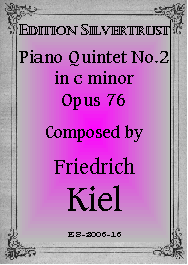Presents
Friedrich Kiel
|
|
|
Piano Quintet No.2 in c minor, Op.76
 Kiel
(1821-1885), who was generally regarded the best composition teacher in Germany
from about 1870 until his untimely death, wrote chamber music of which
the famous critic Wilhelm Altmann wrote:
Kiel
(1821-1885), who was generally regarded the best composition teacher in Germany
from about 1870 until his untimely death, wrote chamber music of which
the famous critic Wilhelm Altmann wrote:
“He produced a number of chamber works, which...need fear no comparison.”
Thus it should come as no surprise that Friedrich Kiel's two piano quintets are as fine as any written in the 19th century--including those of Brahms and Dvorak. They are magnificent works and it is unpardonable that they are not known and have not taken a place in the standard repertoire for this combination. We are very pleased to make these outstanding works available to the public once again.
Kiel was taught the rudiments of music and received his first piano lessons from his father but was in large part self-taught. Something of a prodigy, he played the piano almost without instruction at the age of six, and by his thirteenth year he had composed much music. After passing through the hands of many local teachers, Kiel eventually received a scholarship and went to Berlin with the renowned theorist and teacher Siefried Dehn. In Berlin, Kiel eventually became sought after as an instructor. In 1866, he received a teaching position at the prestigious Stern Conservatory, where he taught composition and was elevated to a professorship three years later. In 1870 he joined the faculty of the newly founded Hochschule für Musik which was shortly thereafter considered one of the finest music schools in Germany. Among his many students were Noskowski, Paderewski and Stanford. Kiel's hobby was mountaineering and at age 60--two years before his tragic death as the result of a traffic accident--he climbed Europe's second highest peak, Monte Rosa.
Kiel's Second Piano Quintet, in five movements, was written immediately after the first and was published at the same time. The first movement, Allegro maestoso, begins with a mysterious introduction and moves through several keys but is quickly overshadowed by the expansive and rich second theme. (our soundbite). Next comes a simple but beautiful Arioso. The middle section (our soundbite) consists of a very attractive waywardly, longing episode. The third movement, an Intermezzo, uses the Mendelssohnian title and to an extent the language but it is really a scherzo. Next is a longish introduction, an Andante, which prepares the way for the finale, Rondo which opens as a lively moto perpetuo. The middle section is a lyrical melody. Another superb work deserving of regular performance.
Parts: $39.95